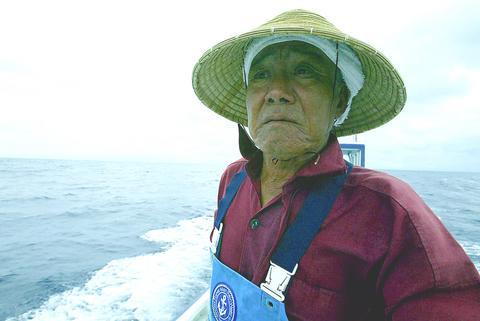The bonito with its large black back and silvery sides flopped aboard the fishing boat, scattering blood on the white deck. After reeling in a couple more, Hiroshi Fukumine, 74, pressed the throttle, and his boat began gaining speed, land receding into the distance.
Over the next hour, as warm waves crashed aboard and left big grains of salt on the skin, the boat roared into the East China Sea, with Fukumine's gaze fixed at a destination known only to himself. For on this morning, as on every other morning, the bonito were just bait for marlin.
Maybe today, as he had one day last year, he would catch a 500kg marlin, the biggest in a lifetime spent prowling the sea. His son, Hiroaki, 51, recently decided to succeed him, and the father spoke of retiring soon. His 74-year-old knees wobbled and his back ached. Age had changed his view of the sea.

PHOTO: NY TIMES
"Before, I was never afraid," he said later that day. "But as I've gotten older, I find myself fearing the waves. The sea can take your life."
Here on Japan's westernmost island, where Taiwan is visible on a clear day, four fishermen in their 70s continue to search the seas for the marlin that ends up on dinner tables across the nation. Born just as the commercial fishing of marlin began here in the 1930s, the old men, like the one in Hemingway's story, used to fish alone in skiffs.
Now the boats are bigger and have engines, but the fishing remains the same. The fishermen drag a bonito, attached to a hook and line, across the waters until a marlin bites, and then fight to reel in a fish that can weigh several times more than they do and that can swim at more than 70kph.
It is a contest the fishermen have often lost, sometimes fatally, before mechanized reels became popular here, about two decades ago.
Back then, once a marlin struck, the line would whip around as the fisherman scrambled to grasp it. Sometimes it would become entangled around his fingers or legs, and the marlin would yank him into the sea. In the most famous case, an 81-year-old named Shigeru Itokazu was killed in 1990 after a line became coiled around his thumb and a marlin pulled him into the sea, shortly after he had appeared as the subject of a documentary, The Old Man and the East China Sea.
A lean man, standing 165cm, Fukumine once had his middle-finger entangled in a line and ripped away by a marlin. A doctor here reattached the finger, but upside-down. He had it properly reattached in Ishigaki, a bigger island in Okinawa, and had missing flesh replaced from his backside.
After World War II, this island served as a focal point for a black-market trade between Japan and Taiwan, China and Hong Kong. Fukumine worked on boats that smuggled goods, like women's clothing, until the US occupying forces cracked down on the black-market trade in 1950. Then over the next two decades, he joined eight-man fishing boats that hauled in several marlin a day, before setting out aboard his own skiff.
Of the old men here, Fukumine is known for his boldness, in going out to stormy seas when others dare not to.
One day two decades ago, when waves were so high that no one else went out to sea, Fukumine did. Trying to reel in a fish, he fell overboard, as his boat moved on toward the island of Iriomote. He drifted for two hours and washed up against some rocks, where a search party found him despite mistaking him at first for a turtle.
These days, Fukumine tends to avoid such risks. So on a recent day when Taiwan became visible -- a sign that can mean, at this time of the year, that a typhoon is approaching -- he did not go out to sea. Instead, he spent the day drinking with fellow fishermen, untalkative at sea but voluble on land over drinks.
On this particular morning, with the waves settling down, he was back on the water, this time with his son. He had pushed so deep into the sea that Yonaguni's elongated silhouette, punctuated by its promontory, had vanished into the horizon.
Hours passed. Fukumine's face remained taut. Father and son rarely talked.
Then in the late afternoon, without saying a word, the son began reeling in the line, but without the urgency that would have suggested a big catch. The bonito had disappeared, as had the hook and part of the line. Only a shark could have swallowed it all, Fukumine said later.
Later that evening, after taking a bath, Fukumine sat alone in his living room. His son's wife had set bonito soup and other dishes on the table before him. He wore a relaxed countenance and a robe open at the chest, revealing an old man's shriveled skin. A support belt for his bad back lay next to him.
"When I don't catch marlin, even alcohol doesn't taste good," he said.
Fukumine spoke of bequeathing the boat to his son by year's end, and of retiring and getting a small one for himself. He was tired of talking, he told his visitors, but answered one more question about whether, after all these years, he loved the sea.
"The sea is beautiful," Fukumine said, then added, "The sea is my friend. It allows me to take fish."

A vaccine to fight dementia? It turns out there may already be one — shots that prevent painful shingles also appear to protect aging brains. A new study found shingles vaccination cut older adults’ risk of developing dementia over the next seven years by 20 percent. The research, published Wednesday in the journal Nature, is part of growing understanding about how many factors influence brain health as we age — and what we can do about it. “It’s a very robust finding,” said lead researcher Pascal Geldsetzer of Stanford University. And “women seem to benefit more,” important as they’re at higher risk of

Last week the Democratic Progressive Party (DPP) said that the budget cuts voted for by the China-aligned parties in the legislature, are intended to force the DPP to hike electricity rates. The public would then blame it for the rate hike. It’s fairly clear that the first part of that is correct. Slashing the budget of state-run Taiwan Power Co (Taipower, 台電) is a move intended to cause discontent with the DPP when electricity rates go up. Taipower’s debt, NT$422.9 billion (US$12.78 billion), is one of the numerous permanent crises created by the nation’s construction-industrial state and the developmentalist mentality it

Experts say that the devastating earthquake in Myanmar on Friday was likely the strongest to hit the country in decades, with disaster modeling suggesting thousands could be dead. Automatic assessments from the US Geological Survey (USGS) said the shallow 7.7-magnitude quake northwest of the central Myanmar city of Sagaing triggered a red alert for shaking-related fatalities and economic losses. “High casualties and extensive damage are probable and the disaster is likely widespread,” it said, locating the epicentre near the central Myanmar city of Mandalay, home to more than a million people. Myanmar’s ruling junta said on Saturday morning that the number killed had

Eric Finkelstein is a world record junkie. The American’s Guinness World Records include the largest flag mosaic made from table tennis balls, the longest table tennis serve and eating at the most Michelin-starred restaurants in 24 hours in New York. Many would probably share the opinion of Finkelstein’s sister when talking about his records: “You’re a lunatic.” But that’s not stopping him from his next big feat, and this time he is teaming up with his wife, Taiwanese native Jackie Cheng (鄭佳祺): visit and purchase a